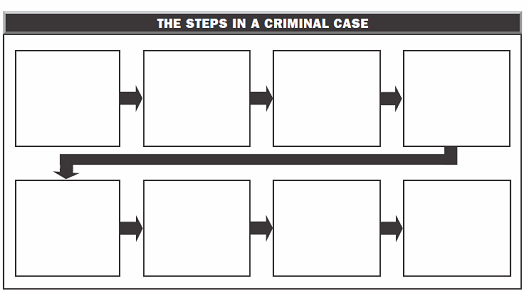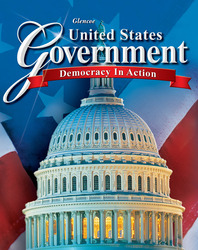United States Government: Democracy in ActionUnit 5:
Liberty and Justice for AllBig Idea Activity <a onClick="window.open('/olcweb/cgi/pluginpop.cgi?it=jpg::::/sites/dl/free/0078799821/680642/big_idea.jpg','popWin', 'width=NaN,height=NaN,resizable,scrollbars');" href="#"><img valign="absmiddle" height="16" width="16" border="0" src="/olcweb/styles/shared/linkicons/image.gif"> (10.0K)</a> <a onClick="window.open('/olcweb/cgi/pluginpop.cgi?it=jpg::::/sites/dl/free/0078799821/680642/big_idea.jpg','popWin', 'width=NaN,height=NaN,resizable,scrollbars');" href="#"><img valign="absmiddle" height="16" width="16" border="0" src="/olcweb/styles/shared/linkicons/image.gif"> (10.0K)</a>
Do the courts administer justice fairly?
Assignment: Sentence the Accused
Create sentencing guidelines for those accused of crimes. Assignment Task List
Step 1: Review the constitutional rights of the accused. Summarize the guarantees in a chart like the one below: Rights of the Accused | Article I, Section 9 | • | Fourth Amendment | •
• | Fifth Amendment | •
•
•
•
•
• | Sixth Amendment | •
•
•
•
•
• | Eighth Amendment | •
• | Fourteenth Amendment | • |
Step 2: Sequence the steps in the criminal justice process. Create a flow chart like the one below. List the steps in a criminal case at the top of each box. Then briefly explain what is involved in each step.
 <a onClick="window.open('/olcweb/cgi/pluginpop.cgi?it=jpg::::/sites/dl/free/0078799821/680642/unit5.jpg','popWin', 'width=NaN,height=NaN,resizable,scrollbars');" href="#"><img valign="absmiddle" height="16" width="16" border="0" src="/olcweb/styles/shared/linkicons/image.gif"> (35.0K)</a> <a onClick="window.open('/olcweb/cgi/pluginpop.cgi?it=jpg::::/sites/dl/free/0078799821/680642/unit5.jpg','popWin', 'width=NaN,height=NaN,resizable,scrollbars');" href="#"><img valign="absmiddle" height="16" width="16" border="0" src="/olcweb/styles/shared/linkicons/image.gif"> (35.0K)</a>Step 3: Discuss sentencing procedures. Who usually determines the sentence? What determines minimum and maximum penalties for a crime? Step 4: Organize into odd-numbered groups. Study the list of crimes below and come to a consensus for the sentence of each crime.
CRIMES AGAINST THE PERSON- Homicide
- Kidnapping
- Robbery
- Attempts to kill
- Assault and Battery
| | CRIMES AGAINST PUBLIC JUSTICE |
- Bribery and corruption
- Falsifying public records
- Perjury
- Intimidating or threatening witnesses
- Money laundering
- Fraud and embezzlement
|
CRIMES AGAINST PUBLIC DECENCY AND GOOD MORALS- Abandonment and neglect of children
- Spousal abusers
- Bigamy
|
CRIMES AGAINST PROPERTY- Arson
- Burglary
- Forgery and counterfeiting
|
Step 5: Go online to investigate your state's penal code. Compare the sentences your group imposed to the real minimum and maximum penalties for each crime. Were your group's penalties more lenient? More strict? Step 6: Regroup as the whole class. Have a spokesperson from each group state the penalties each group decided upon for each crime. Compare the sentences. Should these sentences be mandatory? Should other factors weight the sentences? Explain your responses in a two-paragraph essay.  <a onClick="window.open('/olcweb/cgi/pluginpop.cgi?it=jpg::::/sites/dl/free/0078799821/680642/big_idea.jpg','popWin', 'width=NaN,height=NaN,resizable,scrollbars');" href="#"><img valign="absmiddle" height="16" width="16" border="0" src="/olcweb/styles/shared/linkicons/image.gif"> (10.0K)</a> <a onClick="window.open('/olcweb/cgi/pluginpop.cgi?it=jpg::::/sites/dl/free/0078799821/680642/big_idea.jpg','popWin', 'width=NaN,height=NaN,resizable,scrollbars');" href="#"><img valign="absmiddle" height="16" width="16" border="0" src="/olcweb/styles/shared/linkicons/image.gif"> (10.0K)</a>
After the activity has been completed, use information from your online investigations to discuss this question: Do the courts administer justice fairly?
 | 


















